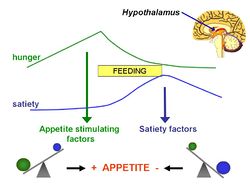Poverty and obesity: Difference between revisions
imported>Ro Thorpe m (moved Poverty and Obesity to Poverty and obesity) |
imported>Ross McEwan |
||
| Line 7: | Line 7: | ||
==References== | ==References== | ||
{{reflist | 2}} | {{reflist | 2}} | ||
<ref>Jeffery Sobal, Albert J. Stunkard, Socioeconomic Status and Obesity: A Review of the Literature, Psychological Bulletin, Volume 105, Issue 2, March 1989, Pages 260-275, ISSN 0033-2909. PMID 2648443</ref> | |||
The review goes into depth with regards to the relationships and comparison between socioeconomic status (SES) and obesity and highlights there to be a strong inverse association regarding females in a developed social culture. Further findings show that the relationship between obesity and SES within a developing society the relationship is expressed directly for that of men, women and children. The review makes it clear that the studies being investigated (144) classify SES based on several factors but most predominantly utilising education or income but on occasions some of the literature reviewed use ‘scales’ regarding alternative measures including occupation. Other points to highlight include the measure of obesity and the reviewed studies have varying methods for such. Predominantly used methods in many of the studies include BMI (height to weight ratio) and skin-fold thickness with some studies using a combination. As there is use of varying measurements this can lead to slight variations regarding the relationship between SES and obesity, but the general findings maintain with a concordant trend from study to study. As being a review article it is able to state conclusions based on the plethora of studies investigated and able to compare that of the develop/developing countries and between men, women and children. It finds that women in a low SES were six times more likely to be obese then those women of high SES in a developed country. Findings regards to the males and children in a developed environment showed no conclusive evidence or trends with studies supporting both males and children to be obese in either a high or low SES or not obese altogether. The review also indicates that men, women and children in developing countries rarely showed any signs of obesity as a whole or no trends regards to the populations as an entity. This could be due to environmental factors such as a general food shortage, or greater energy expenditure due to the lifestyles lived. | |||
Revision as of 15:08, 10 October 2011
For the course duration, the article is closed to outside editing. Of course you can always leave comments on the discussion page. The anticipated date of course completion is 01 April 2012. One month after that date at the latest, this notice shall be removed. Besides, many other Citizendium articles welcome your collaboration! |
Poverty and obesity are very closely linked. In the USA, the highest rates of obesity occur in the poorest population groups. Poverty is associated with lower expenditure on food, and low consumption of fruit and vegetables, and energy-dense foods represent the lowest-cost option for consumers. However, the high energy density and palatability of sweets and fats are associated with higher energy intakes. [1]
References
- ↑ Drewnowski A, Specter SE (2004) Poverty and obesity: the role of energy density and energy costs Am J Clin Nutr 79:6-16 PMID 14684391
The review goes into depth with regards to the relationships and comparison between socioeconomic status (SES) and obesity and highlights there to be a strong inverse association regarding females in a developed social culture. Further findings show that the relationship between obesity and SES within a developing society the relationship is expressed directly for that of men, women and children. The review makes it clear that the studies being investigated (144) classify SES based on several factors but most predominantly utilising education or income but on occasions some of the literature reviewed use ‘scales’ regarding alternative measures including occupation. Other points to highlight include the measure of obesity and the reviewed studies have varying methods for such. Predominantly used methods in many of the studies include BMI (height to weight ratio) and skin-fold thickness with some studies using a combination. As there is use of varying measurements this can lead to slight variations regarding the relationship between SES and obesity, but the general findings maintain with a concordant trend from study to study. As being a review article it is able to state conclusions based on the plethora of studies investigated and able to compare that of the develop/developing countries and between men, women and children. It finds that women in a low SES were six times more likely to be obese then those women of high SES in a developed country. Findings regards to the males and children in a developed environment showed no conclusive evidence or trends with studies supporting both males and children to be obese in either a high or low SES or not obese altogether. The review also indicates that men, women and children in developing countries rarely showed any signs of obesity as a whole or no trends regards to the populations as an entity. This could be due to environmental factors such as a general food shortage, or greater energy expenditure due to the lifestyles lived.
- ↑ Jeffery Sobal, Albert J. Stunkard, Socioeconomic Status and Obesity: A Review of the Literature, Psychological Bulletin, Volume 105, Issue 2, March 1989, Pages 260-275, ISSN 0033-2909. PMID 2648443
